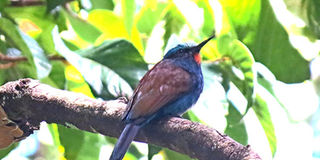OUT&ABOUT: A birding wonderland

Blue-headed Bee-eater, Kakamega Forest. PHOTO| MAYA MANGAT
What you need to know:
- The forest is alive beyond the tropical treat that is Rondo.
- Blue and red-tailed monkeys screech from the high canopies as we thread through the forest beyond the garden before sunset.
It’s a split-second flight, and l miss the brilliant scarlet of the Great Blue Turaco that wears the tag ‘only found in Kakamega Rainforest’.
But I find solace in hearing that these stunning birds are still around. I’m reminded that Africa is the only continent that is home to this bright and brilliant bird.
Dale Zimmerman, the eminent naturalist and lead author of Birds of Kenya and Northern Tanzania — now in his 90s — has authored his latest book titled Turaco Country simply because his first posting as a young man to Africa was to Kakamega Rainforest in the 1960s.
And it was beyond anything he had imagined — pangolins and pottos, vipers and turacos — all in plenty.
But it’s the next bird that l really wanted to see — the African Grey Parrot. Kakamega Rainforest is its only home in Kenya.
AMUSING PETS
The birds live in the Guineo-Congolese Forest that once stretched across the middle of Africa. I’ve only seen these parrots in cages because they make amusing pets.
According to a new report by World Animal Welfare and World Parrot Trust, the horrendous trade in wild-caught parrots has seen their numbers decrease by up to 99 per cent in places like Ghana.
The illegal trade is rife on social media.
The forest is alive beyond the tropical treat that is Rondo. Blue and red-tailed monkeys screech from the high canopies as we thread through the forest beyond the garden before sunset.
I meet Timothy Achevi of Kakamega Forest Tour Guides. I met him for the first time in 2011, when we did a 10-kilometer hike to Yala River from Rondo Retreat.
Yala is an amazing river that flows from the South Nandi Forest, which was once contiguous with Kakamega Rainforest.

Rondo Retreat Garden and Chapel, Kakamega Forest. PHOTO| MAYA MANGAT
The mighty Yala is the main river that flows into Lake Victoria and Yala Swamp filters the water clean before it gushes into the lake.
FROM SLAVERY DAYS
Yala is believed to be derived from the slavery days. When the slave traders reached the river, they would say Ya Allah — thanks be to God — and hence the name.
This time we’re off to Lirhanda Hill — an eight-kilometre round trip from Rondo, the tropical treat in the forest.
I’m happy to hike up, but I keep a watch on the ground for the dreaded siafu or the safari ants. Benjamin Okalo, who knows the forest like the back of his hand, speaks about the three species of safari ants discovered here as recent as 2004.
He tells me the wonders of siafu — and despite some painful experiences with them — l gain new respect for them.
“Ants are the most sensitive animals in the world,” states Okalo. “They have 17 senses while we have five. Ants can sense things a kilometre away.”
In a neatly siafu structured society, the queen is everything. The soldiers do the job of killing other animals after which workers carry away the ladder to feed the queen. Birds like White-tailed Ant-thrush use the ants to search for insects to feed on.
The morning air is tantalising.
Achevi raises eyebrows when l pelt out a list of what l want to see — Rhinocerous viper, Gaboon viper, Gold cobra, potto, pangolin — and l don’t care in which order they come — or else we’re not leaving the forest. He knows as well as l do that we’d have to spend months in the forest if we’re to see any of these rare creatures.
Again, it’s Okalo who has me all excited. “The African Grey Parrot is critically endangered. It finds its food in the forest, from the seeds of a tree called Bughia unijugata. If you cut the forest, the parrots will vanish,” he explains.
I nod in agreement.
“Snakes … we have 18 species. Like the Gold’s cobra and the endemic Kaimosi blind snake.” I make a mental note to look keenly up the trees for Gold’s cobra. It is one of the two cobra types that snakes its way up the trees. It’s very rare, very venomous … just look at it and go away.”
“And the potto, it can only survive if the forest canopy is intact. On the ground, it’s easily killed.” Okalo says even villagers surrounding the rainforest have never seen this cute creature of the night.
We’re on top of the hill having passed though the different layers of towering trees and twisted vines. Guava trees and grass cover the top. It’s because of the cows. The view is breathtaking, with Mt Elgon in the distance and the tree-clad South Nandi Forest.
We hit a score on the way down. In the dense undergrowth dimly lit by dappled light, Achevi suddenly stops. “Look,” he whispers. “It’s the Blue-headed bee-eater. It’s rare and only found here.” I’m elated. Rare, only found here … once common, now you have to really strive to see them. I will have to return to see the rest.




